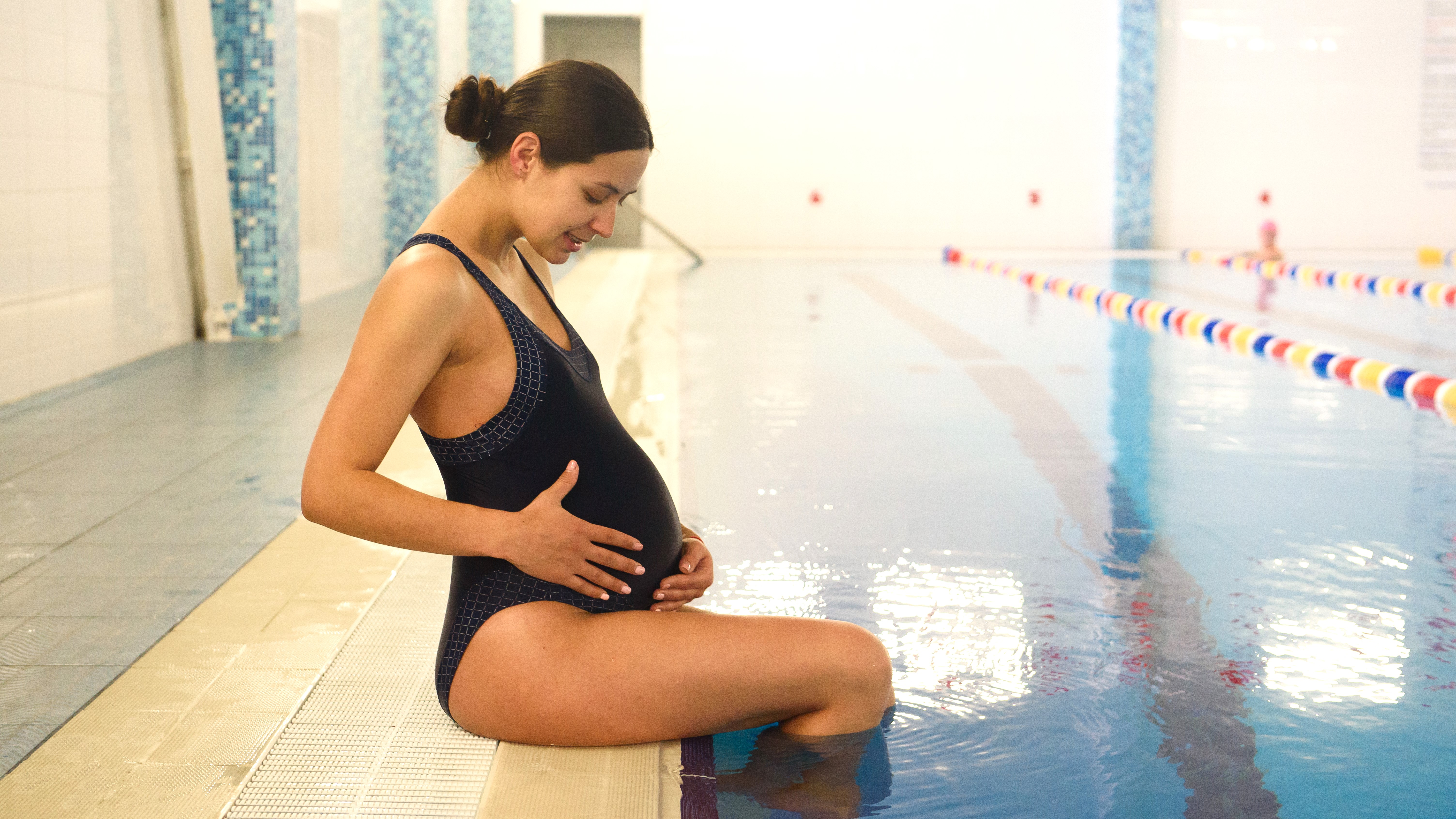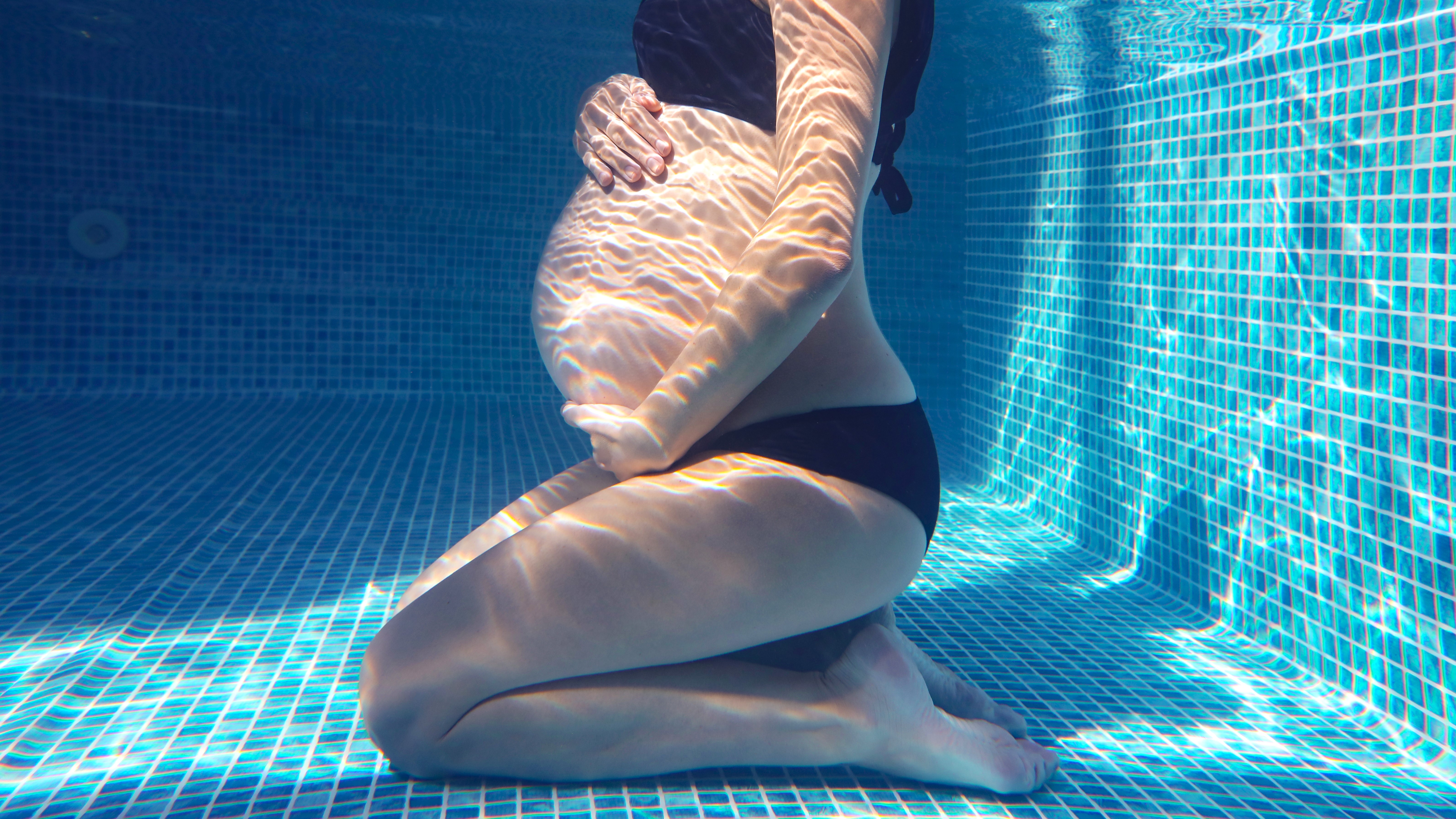
When it comes to exercising with a bump, things can feel overwhelming. We don’t need to tell you there’s a long list of things you shouldn’t do when you’re pregnant — from how much coffee to drink, to which side you should sleep on at night. That said, for most women, the general advice is to still aim for at least 150 minutes of moderate-intensity physical activity when pregnant. So you might be wondering if swimming is safe during pregnancy?
In a nutshell, yes. In fact, the American College of Obstetricians and Gynecologists say that swimming is one of the safest forms of exercise to do during pregnancy. (Just note that this doesn’t include scuba diving.) Unlike other forms of cardio, swimming is low-impact, making it gentler on the body than jogging or cycling. Below, we’ve spoken to an expert to help you separate fact from fiction, before getting into the pool.
Is swimming safe during pregnancy?
“Swimming is safe during and after your pregnancy and we know that there are huge health benefits of staying active throughout. As with all activities, if you are already swimming, keep going!” says Olivia Tyler, Mental Health Prevention Lead at Nuffield Health. If you’re pregnant and finding other forms of exercise too taxing during pregnancy, swimming is a safe way to maintain fitness levels.
But what about if you’re new to swimming? “As with all activities, if you are already swimming, keep going! If you are new to swimming or exercise in general, start slowly and gradually build up the length or intensity of your workouts”, says Tyler.

What are the benefits of swimming during pregnancy?
“Swimming reduces the impact on joints, improves circulation, and gives a well-deserved feeling of weightlessness” during pregnancy, explains Tyler. Like many forms of aerobic exercise, swimming can help you sleep better — sleep can be difficult at various times of pregnancy, so if you are struggling to nod off, this can help.
Water can also be a form of pain relief during pregnancy — even during active labor, there’s a reason why many women opt to use a birth pool. If you’re experiencing swelling or discomfort during pregnancy, swimming might help, although it’s always worth consulting your midwife or doctor if you have any specific medical concerns.
Which swimming stroke is best during pregnancy?
Are there certain swimming strokes you should opt for if you’re swimming with a baby on board? “This is really dependent on how you are feeling and how far along you are – listen to your body. Earlier in your pregnancy do whichever strokes you are comfortable with and that doesn’t cause you discomfort. For most people, breaststroke is advised in early pregnancy as it can help to strengthen the back muscles and encourage better posture but, in some cases, can exacerbate pelvic and back pain so make sure to listen to your body,” explains Tyler.
“Later on in pregnancy, backstroke isn’t advised as the baby can put pressure on blood vessels in this position,” she adds.
It’s also worth being mindful of how you’re swimming during pregnancy. As with most forms of exercise, you shouldn’t be pushing yourself too hard — like other forms of exercise you should stop if you begin to feel nauseous, you become too hot, or you experience any pelvic or abdominal pain. “A good way of making sure that you aren’t over-exerting yourself is the ‘talk test’ which means you are still able to maintain a conversation while exercising,” says Tyler, although this is harder when swimming than it is with hiking or walking.
“Pregnant people should consider avoiding tumble turns during pregnancy due to the potential increase in acid reflux, and also to avoid bumping the bump,” adds Tyler.
Is chlorine safe during pregnancy?
In a word, yes. A study conducted in 2010 found that there were no negative birth outcomes associated with chlorine or any other cleaning products in swimming pools.
What else should you consider?
There are a few other considerations you should make before heading for the pool, lido, or sea:
Temperature
One thing you should be aware of when swimming during pregnancy is the temperature of the pool. Swimming in water that is very warm should be avoided during pregnancy, as you don’t want to put yourself at risk of raising your body temperature. This is why the use of hot tubs, saunas, and hot baths is not recommended during pregnancy, particularly during the first trimester.
At the same time, you should also avoid plunging into freezing lakes and oceans during pregnancy, as this can cause the body a shock. If you’re swimming in the sea, consider tides and remember that you’re likely to get tired quicker during pregnancy, so avoid swimming too far from shore.
Getting in and out of the pool
Be careful when getting in and out of the pool, or walking around the pool when pregnant, as the surface can often be slippery, and you want to avoid falling and knocking your bump.
Stay hydrated
It’s even more important to stay hydrated during pregnancy and when breastfeeding — experts recommend drinking 8 to 12 cups of water per day. Even if you’re not thirsty when getting out of the pool, remember that after exercise, you might need to drink more to replace fluids and avoid dehydration. You might want to leave a bottle of water at the side of the pool and take drinking breaks during your swimming workout.
Invest in a pregnancy swimsuit
Last, but by no means least, you’ll want to be comfortable when swimming during pregnancy, and this probably means investing in a bump-friendly swimsuit. You don’t want to feel self-conscious when exercising in the pool, so buy a swimsuit that has enough stretch to accommodate your growing bump.







